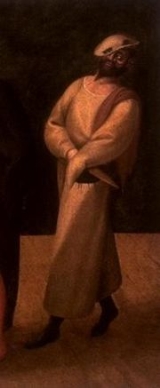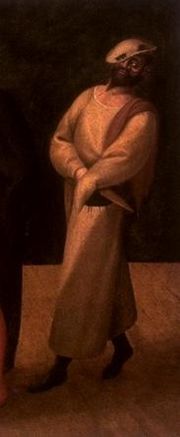
Pedrolino
Encyclopedia
Pedrolino is a zanni
, or servant character in the commedia dell'arte
. His name is essentially the same as "Pete" or "Petey" in English—a diminutive form of the name Peter. He is normally portrayed as personable, charming and kind, to the point of excess—he blames himself for wrongs never done and because of his good and trusting nature is often easily tricked. As John Rudlin says, "He takes a child-like delight in practical jokes and pranks, but otherwise his intrigues are on behalf of his master – he is too honest and self-effacing to do otherwise. At times, however, the best he can scheme for is to escape the punishment others have in store for him." He can be moved to violence when angry, but usually his efforts to beat or kill any other characters are foiled and are ultimately unsuccessful. He wears white clothes, which are occasionally overlarge for him but more commonly are well fitted, and sometimes black accessories. On his head he wears a hat that is either tall and pointed or else small and brimmed. He is very occasionally depicted with a teardrop on his face, and he usually wears no mask; the actor is generally expected to have a great range of facial expression, and this tradition has been in play since at least the start of the 17th century. His face is sometimes whitened with powder or flour.
He wears white clothes, which are occasionally overlarge for him but more commonly are well fitted, and sometimes black accessories. On his head he wears a hat that is either tall and pointed or else small and brimmed. He is very occasionally depicted with a teardrop on his face, and he usually wears no mask; the actor is generally expected to have a great range of facial expression, and this tradition has been in play since at least the start of the 17th century. His face is sometimes whitened with powder or flour.
According to Pierre Louis Duchartre, the character first appears in the 16th century, and by his costume it is easy to guess he evolved from the general-purpose zanni.
's scenario, La Fortunata Isabella, when Pedrolino discovers that his wife Franceschina has been unfaithful, he is tricked into believing that he was drunk at the time that the infidelity was discovered and that he had imagined the whole thing. He ends up begging forgiveness for doubting her, even though his suspicions about Franceschina were entirely true.
A lazzo
cited in Mel Gordon's book shows Arlecchino and Pedrolino armed and ready to face each other in fight. Il Capitano
tries to intervene and steps between them right as they both move to attack, receiving most of the blows himself.
Duchartre tells of a scene where Arlecchino brings a dish of spaghetti to Pedrolino. Pedrolino begins to eat heartily, but weeps all the while. Arlecchino is touched and joins in the eating and crying. Next Burrattino
comes along and also joins in. Once they have eaten all the macaroni they lament even more fervently than ever before.
Zanni
Zanni or Zani is a character type of Commedia dell'arte best known as an astute servant and trickster. The Zanni comes from the countryside. The Zanni is known to be a “dispossessed immigrant worker”. "Immigrant" in Italy at the time of the city-states, did not necessarily mean someone from...
, or servant character in the commedia dell'arte
Commedia dell'arte
Commedia dell'arte is a form of theatre characterized by masked "types" which began in Italy in the 16th century, and was responsible for the advent of the actress and improvised performances based on sketches or scenarios. The closest translation of the name is "comedy of craft"; it is shortened...
. His name is essentially the same as "Pete" or "Petey" in English—a diminutive form of the name Peter. He is normally portrayed as personable, charming and kind, to the point of excess—he blames himself for wrongs never done and because of his good and trusting nature is often easily tricked. As John Rudlin says, "He takes a child-like delight in practical jokes and pranks, but otherwise his intrigues are on behalf of his master – he is too honest and self-effacing to do otherwise. At times, however, the best he can scheme for is to escape the punishment others have in store for him." He can be moved to violence when angry, but usually his efforts to beat or kill any other characters are foiled and are ultimately unsuccessful.

According to Pierre Louis Duchartre, the character first appears in the 16th century, and by his costume it is easy to guess he evolved from the general-purpose zanni.
Examples of Pedrolino's behavior
In one of Flaminio ScalaFlaminio Scala
Flaminio Scala was an Italian comedian and stage actor, one of the most important figures of Commedia dell'Arte.-Il Teatro Delle Favole Rappresentative:...
's scenario, La Fortunata Isabella, when Pedrolino discovers that his wife Franceschina has been unfaithful, he is tricked into believing that he was drunk at the time that the infidelity was discovered and that he had imagined the whole thing. He ends up begging forgiveness for doubting her, even though his suspicions about Franceschina were entirely true.
A lazzo
Lazzi
Lazzi is an improvised comic dialogue or action commonly used in the Commedia dell'arte. Most English-speaking troupes use the Italian plural "lazzi" as the singular and "lazzis" for the plural....
cited in Mel Gordon's book shows Arlecchino and Pedrolino armed and ready to face each other in fight. Il Capitano
Il Capitano
Il Capitano is a masked character from the commedia dell'arte. He is often an outside who can maintain his claims only by benefit of the fact that none of the locals know him. He is usually a Spaniard given the fact that for most of the late Renaissance to well into 17th century, Italy was under...
tries to intervene and steps between them right as they both move to attack, receiving most of the blows himself.
Duchartre tells of a scene where Arlecchino brings a dish of spaghetti to Pedrolino. Pedrolino begins to eat heartily, but weeps all the while. Arlecchino is touched and joins in the eating and crying. Next Burrattino
Burrattino
Burrattino, also Burattino or Burratino, is a minor character from the Commedia dell'arte, of the stupid zanni class. He is a variant on the character Pedrolino. Burattino means wooden puppet or doll in Italian....
comes along and also joins in. Once they have eaten all the macaroni they lament even more fervently than ever before.
Variants
- PierrotPierrotPierrot is a stock character of pantomime and Commedia dell'Arte whose origins are in the late 17th-century Italian troupe of players performing in Paris and known as the Comédie-Italienne; the name is a hypocorism of Pierre , via the suffix -ot. His character in postmodern popular culture—in...
- BurrattinoBurrattinoBurrattino, also Burattino or Burratino, is a minor character from the Commedia dell'arte, of the stupid zanni class. He is a variant on the character Pedrolino. Burattino means wooden puppet or doll in Italian....
- BertoldoBertoldoThe Bertoldo was a weekly magazine of surreal humour that run under Italian Fascism. While the Becco Giallo magazine put out a courageus political satire against the fascist regime, the reactionary authors of the Bertoldo, like Marcello Marchesi, as well as thise of Marc'Aurelio, developed a kind...
- Pagliaccio
- Peppe Nappa
- Gian-Farina

